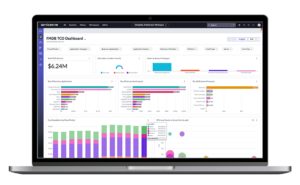Overall interest in ITFM/TBM has grown steadily over the past several years. But in 2020, there are several trends that will likely cause that interest to grow faster than ever.
Here are five trends that will drive considerable growth for the ITFM/TBM space in 2020…
Most IT Budgets Will Keep Climbing
Achieving cost transparency across large budgets has always been a core motivator for organizations to pursue ITFM/TBM. Because as budgets grow bigger and more complex, IT must have proper visibility to make smart investment decisions, defend costs, and demonstrate value.
And based on today’s data, the importance of cost transparency will only become stronger as technology budgets trend upward throughout 2020:
- Gartner expects global IT spending to rise 3.7% to roughly $3.9 trillion in 2020.
- In the Harvey Nash / KPMG CIO Survey 2019, more IT leaders reported increases to their technology budgets than any time in the past 15 years.
- According to a recent global survey by Spiceworks, 88% of respondents expected their budgets to grow or remain static over 2020, with anticipated increases sitting around 18% on average.
Appetites for Digital Transformation Are Getting Even Stronger
As IT budgets grow, business leaders’ expectations are growing too. Businesses may be investing more money in IT, but they’re doing so based on the expectation that IT will use that money to drive growth and change; new funding doesn’t come without strings attached.
In response, IT leaders must prioritize new initiatives wisely, while ensuring operating expenses aren’t quietly wasting potential innovation dollars.
- In the Gartner 2020 Board of Directors Survey, respondents indicated that digital business/technology-driven disruption was the most important external trend shaping their strategy.
- According to Flexera’s 2020 State of Tech Spend Report, 54% of respondents cited digital transformation as their #1 priority for 2020.
Cloud Challenges Aren’t Going Away
Managing cloud spend has proven exceedingly difficult in recent years, especially in the context of large, multi-cloud portfolios. Granted, the cloud promises improved performance at a lower cost; but without proper oversight, it can quickly grow into a massive source of hidden waste.
That said, attempting to govern cloud spend without a single source-of-truth will always leave money on the table — an issue that will only become more problematic 2020:
- InfoWorld reports that cloud costs now represent ¼ of total IT spend on average, and they’re expected to climb higher over the months ahead — with the worldwide market for cloud services forecasted to grow 17% in 2020 alone, according to Gartner.
- In 2019, RightScale estimated average cloud waste to sit around 35%.
- According to Gartner, over 80% of organizations using public cloud are working with more than one provider; Flexera reports organizations are leveraging five clouds on average.
The “IT-as-an-enabler” Model Is Being Abandoned
Historically, IT has served in a more enabler-based, “order-taker” role, where the business dictates requirements and IT simply decides how to execute. Now that paradigm is starting to shift, with technology leaders working to increase agility and efficiency via self-service options.
But as IT pivots to offer more self-service capabilities, the need for accurate costing and management of services will undoubtedly increase:
- Gartner reports that 58% of organizations were already delivering some degree of IT self-service capabilities, and 32% more will do so in 2020.
- According to the IDC FutureScape: Worldwide CIO Agenda 2020 Predictions report, “By 2024, 80% of digitally advanced organizations will replace the walled garden, IT-as-an-enabler model with a self-service model.”
Shadow / Business-led IT Isn’t Slowing Down
According to Gartner, business-led/shadow IT has grown to an average of 36% of the total IT budget. And with the increasing “democratization” of technology services available in the market, that number will only get bigger; when business users aren’t satisfied with the offerings available through IT, a whole host of third-party solutions will welcome them with open arms.
Considering that non-sanctioned IT purchases are only becoming easier to make — plus the business’s increasing desire to implement solutions without IT’s support — technology leaders must have an intentional strategy to capture and govern all spend occurring outside their purview:
- IDC forecasts that business-led/shadow IT could grow over 5% in 2020.
- In 2020, Gartner predicts that ⅓ of successful cyber attacks will be executed against shadow IT resources.
Leveraging ITFM/TBM for Success in 2020 and Beyond
Many technology organizations still bear the designation of “black box” cost center, but maintaining that status quo in today’s enterprise environment carries serious risk. IT leaders will be forced to transform their organizations or suffer the consequences — poor credibility, waste and inefficiency, and limited innovation capacity to name a few.
That’s why strategically-minded IT leaders will drastically change their approach to IT Finance over the next five years — assuming they aren’t working to do so already — and ITFM/TBM is a key enabler to accomplish that goal.
IDC reports (via CIO.com), “Through 2024, 75% of CIOs will reshape all IT resources, including budgets, assets, and talent, to support real-time resource allocation and enterprise agility, dramatically reducing fixed costs.”
To learn more about how ITFM/TBM can help your organization adapt and thrive in today’s rapidly changing conditions, reach out today to start the conversation.





